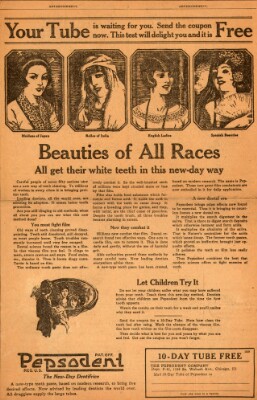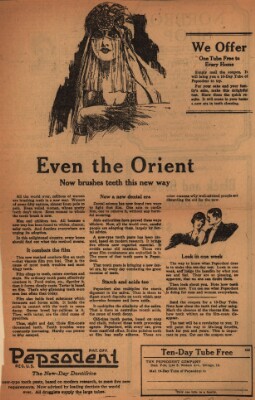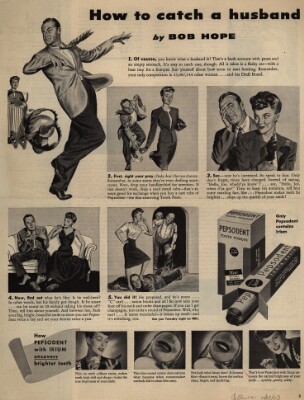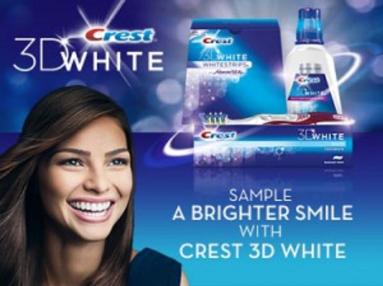
While skin-evening creams, skin-lighteners, skin-brighteners, skin-whiteners, skin-toners, fading creams, fairness creams, and whatever else companies choose to brand them as [1] are a fairly clear artifact of white supremacy, I wonder about the role of similar whitening products, like those for teeth.

In 1922, Pepsodent marketed a tooth paste [2][3] that not only sought to whiten people’s teeth but did so via the discourse of Orientalism [4]—Western exotification and fetishization of Asian peoples. That is, by playing upon people’s notions of the ‘Orient’ and other cultures as inferior, backward, and uncivilized and saying that “Even the Orient” whiten their teeth by using Pepsodent, then the targeted audience is made to feel not modern. Indeed, “Old ways of teeth cleaning proved disappointing.” In addition, this mirrors how “images of white beauty sell an entire lifestyle,” including modernity [5].

What’s more, white teeth and it’s role as beauty capital [6] was tied in a 1943 ad [7] to the social endeavor of finding a husband. Specifically, it details steps on how to catch a husband, with the answer being using Pepsodent tooth paste. In other words, beauty capital (in the form of white teeth) is used to access social capital (in the form of a husband) and economic capital (in that the husband is “a bank account with pants”).
Furthermore, in these ads, science, in tandem with pathology, is used as a legitimizing discourse in order to sell their product. In other words, film on teeth pathologizes a lack of white teeth and “dental science has now found two ways to fight that film,” providing a solution to this pathologization. Looking at advertisements today, these very discourses continue.

Of course, one should take care of one’s teeth and ensure their health. However, at what point does this health intervention become a cosmetic intervention? Or is it both at once? (I’m reminded of glasses as an aesthetic element.) Furthermore, what differentiates dental work as body labor [8] from a pedicure? That is, what allows dentistry to be legitimized and substantiated in a way that nail artistry is not? Moreover, considering that both are mutable features, what leaves teeth relatively unraced but hair incredibly raced and politicized?
Further reading & material:
Rising out of this socio-historical landscape, Zadie Smith wrote the book White Teeth.
Fairly Oddparents, Chip Skylark’s “Shiny Teeth and Me”
Works Cited
[1] Margaret Hunter, “Buying Racial Capital: Skin-Bleaching and Cosmetic Surgery in a Globalized World,” The Journal of Pan African Studies 4, no. 4 (2011): 148.
[2] “Beauties of All Races,” Ad*Access, 1922, https://repository.duke.edu/dc/adaccess/BH2344.
[3] “Even the Orient,” Ad*Access, 1922, https://repository.duke.edu/dc/adaccess/BH2343.
[4] Edward W. Said, Orientalism (New York: Vintage Books, 2004).
[5] Margaret Hunter, “Buying Racial Capital: Skin-Bleaching and Cosmetic Surgery in a Globalized World,” The Journal of Pan African Studies 4, no. 4 (2011): 144.
[6] Meeta Rani Jha, The Global Beauty Industry: Colorism, Racism, and the National Body (New York, NY: Taylor & Francis, 2016), 4.
[7] “How to catch a husband,” Ad*Access, 1943, https://repository.duke.edu/dc/adaccess/BH2349.
[8] Miliann Kang, “The Managed Hand: Race, Gender and the Body in Beauty Service Work,” (University of California Press, 2010).


After I got my braces off, one of the first things I did was go to Target and buy whitening strips. My teeth were yellow and splotchy from a year and a half of metal in my mouth. While i see the beauty and social capital that go along with whitening teeth, I think that something that is important to note is the long-time obsession with perfect teeth. For example, a lot of people believe that they should get braces to fix their teeth if they’re not “straight.” Braces are expensive and are very highly encouraged. “White lifestyle” as explained by Hunter in her article is what I’m thinking about right now. Straight teeth are usually associated with braces and braces are always associated with the fact that they cost so damn much. Now, however, gap-teeth are considered to be the new look. The new obsession is now authenticity and naturalness. “Love the skin your in” type of shit. The myth is that gap-tooth people are ‘lucky’ in life, funny, and intelligent. Models such as Lindsey Wixon and Abbey Lee are sought after because of the gap between their teeth. People are even going so far as to have surgery done to PUT a gap in-between their front teeth. I think this topic is definitely something to be explored further in terms of white lifestyle and the desire to have desirable features — however, the “love for the imperfect” has become the new “perfect.” (Now I’m thinking about Justin Bieber and his song “All Around the World” — ‘I love everything about you, you’re imperfectly perfect’.)
LikeLike
This made me think about my group conversation about the intersection of medicine discourse and aestetics. Where is the line between beautifying and medicine? It is interesting to think about when it began that we needed our teeth to be “white” rather than “healthy.” Esotericks writes, “However, at what point does this health intervention become a cosmetic intervention? Or is it both at once? (I’m reminded of glasses as an aesthetic element.) Furthermore, what differentiates dental work as body labor [8] from a pedicure? That is, what allows dentistry to be legitimized and substantiated in a way that nail artistry is not?” This is especially true when thinking about the amount of people that are going into dentistry these day. When a person is a dentist, they are paid the same wage as doctors, but more flexible hours. Therefore, in the future, society will be reinforcing these ideas of perfection within teeth and the market that has been created.
LikeLike
Like Caroline, this blog post causes me to reflect on conversations our group has had about the problematic intertwining of “health” language and “beauty” language. In my reflections, I have thought a great deal about how “health” language, the language of medicine and of science, is used to legitimize practices to the public, while “beauty” language is used to market practices to a public that has been taught that “beauty” is the goal. I wonder if this has to do with how both of those discourses have been gendered; for example, in the contemporary “fitspiration” movement, the old norm of losing weight/striving for a particular aesthetic is dismissed, which is connected to society’s dismissal of the “feminine,” while being “strong” and thus healthy, which is traditionally “masculine”, is touted as revolutionary and acceptable. Thus, the mantra “strong is beautiful” — the goal is “masculine” and thus legitimate, but expressed in a “feminine” idiom.
In addition, I reflect on my own experience with my teeth. Although I wore headgear every night for almost three years, my parents rejected braces as a solution for my remaining overbite because my teeth were not “bad enough.” Yet, I continue to feel self-conscious about the overbite that remains, along with the yellowness of my teeth caused by extensive coffee consumption. However, I have not gone so far as to seek further modification of my teeth, or teeth-whitening products. I reflect on how I am mediating the social perception of “acceptability”; like in Kathy Davis’s work on plastic surgery, since my teeth fall within the realm of the “acceptable”, am I reluctant to modify them further? Does the notion of “acceptable”, and how much modification is warranted, differ in the case of teeth and in plastic surgery? Is there some connection to how plastic surgery is feminized, and thus taken less seriously, versus the “universal” teeth norms?
LikeLike